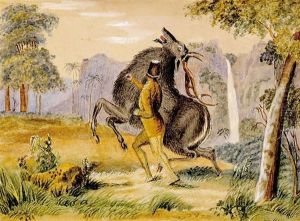Cornelia Jefferson Randolph Paintings
Cornelia Jefferson Randolph was an American artist born on February 27, 1799, at Monticello, which was the estate of her grandfather, Thomas Jefferson, the third President of the United States. She was the daughter of Martha Jefferson Randolph and Thomas Mann Randolph Jr., who served as the Governor of Virginia. Growing up in an environment with a strong emphasis on education and culture, Cornelia was exposed to the ideals of the Enlightenment which her grandfather espoused.
Cornelia was one of the few female artists of her time to receive a significant amount of recognition for her work. Despite the limitations placed on women in the arts during the early 19th century, she managed to develop her skills and achieve a degree of acclaim. She was particularly noted for her portraits, which were primarily executed in watercolor and pastel. Her artistic style was influenced by the genteel tradition of portrait miniatures, which was popular among the American gentry of the time.
Throughout her life, Cornelia remained unmarried, which was somewhat unusual for women of her social standing during the period. Instead, she dedicated herself to her family and her art. She served as a hostess for her grandfather at Monticello and played a significant role in managing the household. After Jefferson's death in 1826, Cornelia continued to live at Monticello with her mother and siblings, eventually managing the estate.
Cornelia Jefferson Randolph's legacy as an artist is closely tied to her family heritage and the historical context of her time. Her portraits offer a glimpse into the world of the Virginia plantation aristocracy in the early 19th century. Although not as widely known as some of her contemporaries, her works are valued for their historical significance and their portrayal of prominent figures of the era.
Cornelia lived through the American Civil War, witnessing the profound changes it brought to her society. She died on July 10, 1871, having lived a life that spanned a significant period of American history, from the early days of the republic through the Civil War and the beginning of Reconstruction. Her works remain as a testament to her artistic ability and the cultural milieu from which she emerged.
